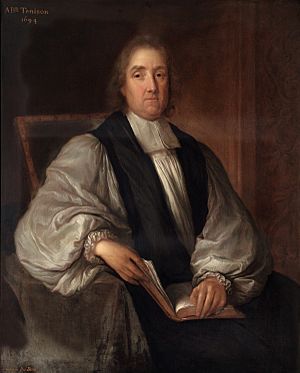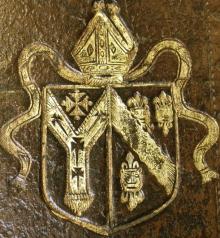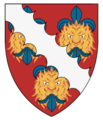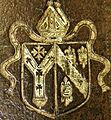Thomas Tenison facts for kids
Quick facts for kids The Most Reverend and Right Honourable Thomas Tenison |
|
|---|---|
| Archbishop of Canterbury | |

Portrait by Simon Dubois
|
|
| Church | Church of England |
| Diocese | Canterbury |
| In Office | 1695–1715 |
| Predecessor | John Tillotson |
| Successor | William Wake |
| Orders | |
| Consecration | 10 January 1692 by John Tillotson |
| Personal details | |
| Born | 29 September 1636 Cottenham, Cambridgeshire, England |
| Died | 14 December 1715 (aged 79) London, England |
| Nationality | English |
| Denomination | Anglican |
| Spouse | Anne Love |
| Education | Norwich School |
| Alma mater | Corpus Christi College, Cambridge |
Thomas Tenison (born September 29, 1636 – died December 14, 1715) was an important English church leader. He served as the Archbishop of Canterbury from 1694 until his death. This was a very high position in the Church of England. During his time as Archbishop, he had the important job of crowning two British kings and queens.
Contents
The Early Life of Thomas Tenison
Thomas Tenison was born in Cottenham, a village in Cambridgeshire, England. His father and grandfather were both Anglican clergymen, meaning they were priests in the Church of England.
Education and Early Career
Thomas went to Norwich School and then studied at Corpus Christi College, Cambridge. He became a fellow there in 1659. For a short time, he even studied medicine. However, he decided to become a priest and was ordained in 1659.
From 1662, he worked as a curate in Cambridge. He was known for helping people during the plague, showing great care for those who were sick. Later, he became the priest for churches in Holywell and Needingworth, and then in St Peter Mancroft, Norwich.
Becoming a Doctor of Divinity
In 1680, King Charles II appointed him to lead the important London church of St Martin-in-the-Fields. Thomas Tenison earned a special degree called Doctor of Divinity. He was known for setting up schools, like Archbishop Tenison's School, Lambeth (1685) and Archbishop Tenison's School, Croydon (1714). He also started a public library.
Tenison was a strong opponent of the Church of Rome. He wrote a book in 1678 called A Discourse of Idolatry, where he spoke against practices he saw as wrong. He also preached sermons that were sometimes challenged by others.
Role During Political Changes
In 1685, before his execution, the Duke of Monmouth asked to see Tenison. While other bishops were not satisfied with Monmouth's repentance, Tenison spoke to him kindly, though he also felt Monmouth's sorrow was not enough.
Under King William III, Tenison became part of a special group in 1689. This group was formed to help bring different Christian groups together and to update church services.
Tenison supported the Glorious Revolution, which changed who ruled England. Even though he had some private concerns about how the previous Archbishop was removed, he believed it was important to support the new government. He famously said that while there were problems, "we were now to make the best of it, and support this government as it was, for fear of a worse."
He also preached a funeral sermon for Nell Gwyn in 1687, showing his kind and understanding nature. Because of his open-minded religious views, he gained royal favor. He became Bishop of Lincoln in 1691 and then Archbishop of Canterbury in December 1694.
Archbishop of Canterbury
As Archbishop, Thomas Tenison was a very important figure.
Serving the Monarchy
He was with Queen Mary during her final illness and preached at her funeral. In 1695, when King William went to lead the army in the Netherlands, Tenison was one of seven special leaders called "lords justices." They were given the power to govern England while the King was away.
After Queen Mary's death, Tenison helped convince King William to make peace with Mary's sister, Anne. This was important because their disagreement had made the royal family look weak. In 1695, Tenison also became a member of the Privy Council of England, which gave him the special title "The Right Honourable" for life.
Under Queen Anne
Thomas Tenison continued to serve the monarchy, even though his relationship with the new Queen was sometimes difficult.
Challenges with Queen Anne
He was with King William when he died and then crowned William's successor, Queen Anne. However, during Queen Anne's reign, Tenison was not as popular at court. The Queen felt he was too supportive of the "Low Church" (a group within the Church of England). They often disagreed about who should be appointed as bishops.
For example, when Tenison tried to suggest someone for the position of Bishop of Winchester, Queen Anne quickly told him that "the matter was decided." It was very hard for him to convince her to appoint William Wake as Bishop of Lincoln, even though Wake was his preferred choice.
Over time, Tenison's influence at court decreased. John Sharp, the Archbishop of York, became more favored by the Queen. Tenison was involved in the Union with Scotland in 1706, which joined England and Scotland into Great Britain. However, in the last years of Queen Anne's reign, he was not a major political figure.
Supporting the New King
Tenison strongly supported the idea that the Hanoverian family should take the throne after Queen Anne. He was one of three important officials who helped choose a temporary ruler until George I arrived. He then crowned King George I on October 20, 1714. This was the last time an Archbishop asked the people if they accepted their new King during a coronation.
Thomas Tenison passed away in London a year later. He played a key role in making sure the writings of Sir Thomas Browne, known as Christian Morals, were published after Browne's death.
Other Contributions
Besides his sermons and writings about the "Popish" (Catholic) controversy, Tenison wrote The Creed of Mr Hobbes Examined (1670) and Baconia, or Certain Genuine Remains of Lord Bacon (1679). He was also one of the people who helped start the Society for the Propagation of the Gospel, an organization that spreads Christian teachings.
Family Life
Thomas Tenison married Anne Love, but they did not have any children. His cousin, Edward Tenison (1673–1735), became the Bishop of Ossory in Ireland. Another relative, Richard Tennison (1642–1705), became the Bishop of Meath. Thomas is said to have helped Richard in his career. In his will, Thomas left money to all five of Richard's sons.
People described Thomas Tenison as a large, strong man. In his later years, he suffered from gout, a painful joint condition.
Coat of Arms
Archbishop Tenison's personal coat of arms combines the arms of the see of Canterbury with his family's arms. The Canterbury arms are on the left side (from the wearer's view) and show a golden archiepiscopal cross with a special cloth called a pall.
The Tenison family arms are on the right side. They feature a red background with a white diagonal band that has wavy edges, and a narrower blue band in its center. This design is placed between three gold leopard's faces, each with a fleur-de-lys (a lily-shaped symbol) coming out of its mouth.
These arms are a slightly different version of the old arms of the Denys family from Gloucestershire. The Tenison family might have adopted them because their name sounds like "Denys's son." A similar version of these arms was also used by the family of the famous poet Alfred, Lord Tennyson, though he was not a direct descendant of Archbishop Thomas Tenison.
Possible Discovery of His Coffin
In 2016, during renovations at the Garden Museum (located in the old St Mary-at-Lambeth church), 30 lead coffins were found. One of them had an archbishop's red and gold hat (mitre) on top. Two archbishops were identified by nameplates. Church records suggest that three more archbishops, including Thomas Tenison, might be buried in that vault.
See also
- Archbishop Tenison's School, Croydon
- Archbishop Tenison's School, Lambeth
- List of Archbishops of Canterbury
Images for kids







